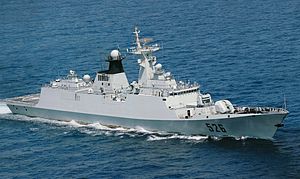A Chinese People’s Liberation Army-Navy Type 815 Dongdiao-class spy ship entered Japanese territorial waters on Wednesday, according to Japan’s defense ministry. The move is the first of its kind since 2004, when a Chinese nuclear submarine entered Japan’s 12 nautical mile territorial sea near Sakishima Islands, in Okinawa prefecture.
According to a Kyodo News report of the Wednesday’s incident, a “naval intelligence ship was spotted around 3:30 a.m. west of Kuchinoerabu Island.” The ship “left the territorial waters just a few hours later.” (Japan’s Defense Ministry notes that the ship left around 5 a.m.) Kuchinoerabu Island is approximately 38 nautical miles from the Japanese island of Kyushu, which is one of Japan’s four main islands along with Honshu, Hokkaido, and Shikoku.
Japan and China have a territorial dispute in the East China Sea over the sovereignty of the Senkaku/Diaoyu Islands, which are administered by Japan, but claimed by China. Wednesday’s incident did not take place in the vicinity of these islands. (The Senkakus are approximately 450 nautical miles from Kuchinoerabu Island.) Last week, however, for the first time ever, a Chinese warship entered the contiguous zone of the Senkaku/Diaoyu Islands, in a move that highlights growing tensions between the two countries in the East China Sea.
It’s unclear if Wednesday’s incident saw the Chinese warship comply with international law under the United Nations Convention on the Law of the Sea (UNCLOS), the international treaty on maritime law that both Japan and China have ratified. Under Article 18 of UNCLOS, foreign warships are permitted “continuous and expeditious” passage through another state’s territorial sea provided they comply with the provisions governing “innocent passage,” detailed in Article 19.
One of the requirements of innocent passage is that ships traverse across the territorial sea without engaging in intelligence collection activities. The fact that China sent the Dongdiao-class, an intelligence-gathering vessel, and lingered for what Kyodo described as a “few hours” suggests that Japan may have reason to believe that the PLAN vessel did not comply with innocent passage requirements. This, however, remains indeterminate based on what information the Japanese Defense Ministry has disclosed so far.
Wednesday’s incident reinforces the notion that the East China Sea is heating up this summer, potentially drawing some attention away from the South China Sea, which has been particularly fraught due to ongoing Chinese militarization and U.S.-China standoffs over freedom of navigation patrols and other activities.
As I discussed last week, the entry of PLAN vessels into the contiguous zone around the Senkaku/Diaoyu Islands (accompanied by three Russian vessels) marked an unusual first in the East China Sea, particularly when China, along with several regional states, anticipates the verdict of the Permanent Court of Arbitration in Philippines v. China. (The case will rule on the status of several features in the South China Sea; not on sovereignty.)

































